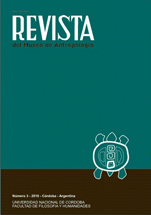Argentine Ethnography: Monsignor Pablo Cabrera’s free lecture (1925)
DOI:
https://doi.org/10.31048/1852.4826.v3.n1.5462Keywords:
University reform, teaching, anthropology, Pablo Cabrera, Córdoba, ArgentinaAbstract
The groundbreaking Reform that took place at the National University of Córdoba (Universidad Nacional de Córdoba, UNC) in 1918, paved the way to the academic start of anthropology in Central Argentina. This new presence was fostered by two initiatives of the students’ sector: extra-curriculum or “free” courses, and public contests to professors’ positions. The latter was meant to exclude the Catholic and conservative personnel from the leading and teaching positions and from the administration, and to ensure access of the “most capable and dignified” professors to the University, in the name of capacity, justice and freedom. This paper explores a direct effect of such initiatives which seem to oppose such goals: the launching of the first free course of Argentine Ethnography by Prior (Monseñor) Pablo Cabrera (1857-1936) in 1925. Cabrera, its main professor, was a member of the Catholic Church of Córdoba and of the National Academy of Sciences, the director of the Provincial Historical Museum, and the author of myriad books and articles on Revista de la Universidad and the newspaper Los Principios. ¿Why and how a man of the Church launched this innovation in the anti-clerical context of the University Reform? How did his confessional adscription affect Cabrera’s work in a secular institution and conversely how did his academic stance impinge on his priestly activities? In sum, how could these two realms coexist within the single mind of a man acknowledged as the predecessor of Cordobesa anthropology?Downloads
References
Aguiar, L. 2008. Ni presión de sectores medios, ni una mera “juvenilia” algo más sobre la Reforma Universitaria. Reseñas de enseñanza de la Historia, Publicación de APEHUN (Asociación de Profesores de Didáctica de la Historia de Universidades Nacionales), N° VI, septiembre: 311-342.
Cabrera, P. 1883. Fundamentos de la Religión. Tipografía “Bazar Madrileño”, Mendoza.
Cabrera, P. 1883. Los liberales de Aquende y los liberales de Allende o sea el Si y el No acerca de la enseñanza religiosa en las escuelas populares. Tipografía “Bazar Madrileño”, Mendoza.
Cabrera, P. 1904. Cristo en la Cumbre. Compañía Sud. Americana de Billetes de Banco, Buenos Aires.
Cabrera, P. 1910. Ensayos sobre Etnología Argentina. Tomo 1 Los Lules, Universidad Nacional de Córdoba, Córdoba.
Cabrera, P. 1920. Trejo y su obra: a propósito de una publicación adversa a entrambos, B. Cubas, Córdoba.
Martinez Paz, E. 1914. Revista de la Universidad Nacional de Córdoba. Revista de la Universidad, número 1, agosto: 3-8.
Requena, P. 2008. Universidad, política y cultura en la córdoba intersecular o pensar la Reforma Universitaria de 1918 en la mediana duración, 1871-1920. Reseñas de enseñanza de la historia, Publicación de APEHUN (Asociación de Profesores de Didáctica de la Historia de Universidades Nacionales), número VI, septiembre: 287 - 310.
Vidal, G. 2005. La modernidad y el espacio público en Argentina. Repensado la Reforma Universitaria de1918. Avances del CESOR, año V, Nº 5, Rosario.
Vidal, G. 2007. La Reforma Universitaria de 1918 y la Unión Cívica Radical.
Vidal, G. La política y la gente. Estudios sobre modernidad y espacios públicos. Córdoba, 1880-1960, Ferreyra Editor, Córdoba.
Downloads
Published
Issue
Section
License
Those authors who have publications with this Journalaccept the following terms:
a. Authors will retain their copyrights and guarantee the journal the right of first publication of their work, which will be simultaneously subject to the Creative Commons Attribution License (Licencia de reconocimiento de Creative Commons) that allows third parties to share the work as long as its author and his first publication in this journal.
b. Authors may adopt other non-exclusive licensing agreements for the distribution of the version of the published work (eg, deposit it in an institutional electronic file or publish it in a monographic volume) provided that the initial publication in this journal is indicated.
c. Authors are allowed and recommended to disseminate their work on the Internet (eg in institutional telematic archives or on their website) before and during the submission process, which can lead to interesting exchanges and increase citations of the published work. (See The Effect of Open Access - El efecto del acceso abierto)












